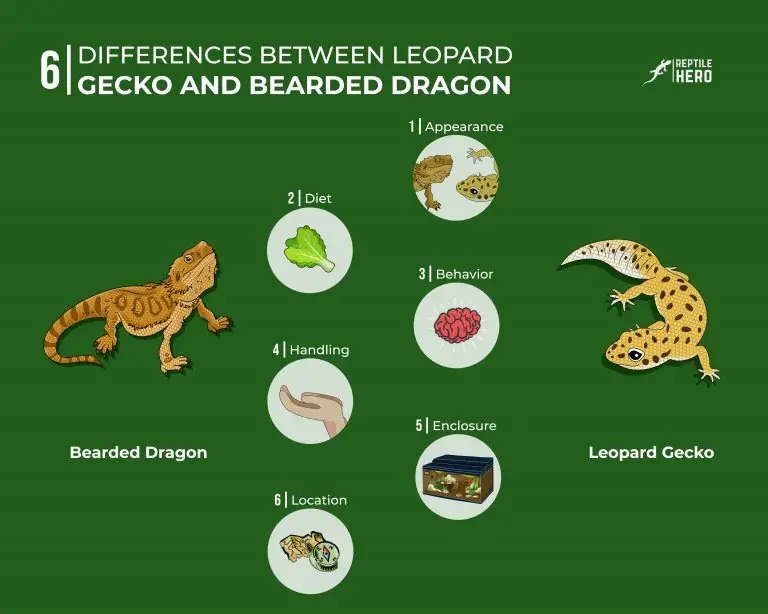Is Your Tokay Gecko Male or Female? (Check the Pores!)
Tokay geckos can be really feisty, sure. But that doesn’t make them any less fascinating. But how can you make sure that you can identify if they are male or female without getting bitten? Is that even a doable task for regular tokay keepers?
Sex determination in tokay geckos can be done based on the pores, bulges, and spurs near their vent and the calcium sacs in their mouths and necks. Male tokay geckos have big pores and spurs but have small bulges and calcium sacs. However, female tokay geckos have big calcium sacs but little to no pores, spurs, and bulges.
Afraid of getting chomped on by a tokay while you try to sex it? No worries, you have the option to get your tokays sexed by professionals! Just keeping reading to learn more!
Sexing Male vs Female Tokay Geckos (4 Signs!)
Tokay geckos can be sexed once they reach 35–50 g at approximately 6–9 months old. But their sex is determined by genetics. Keepers can differentiate male tokays from females by checking their pores, bulges, spurs, and calcium sacs.
Unlike the first two commonly kept gecko species, the temperature tokays experience in the egg doesn’t dictate their sex. Rather, the sex of tokay geckos is determined by genetics [1].
Similar to humans, tokay geckos also have X and Y sex chromosomes. For female tokays, it’s XX. In males, it’s XY.
So regardless of the temperature tokay gecko eggs are kept at, they will retain and express their sex chromosomes once they become sexually mature. But this doesn’t make sex identification any easier in tokay geckos.
You probably don’t have the necessary knowledge and equipment to understand and take a closer look at your pet tokay’s genetic data though. As such, it’ll be better for you to familiarize yourself with their notable sex-defining features!
Experts recommend owners wear thick protective gloves when trying to sex a tokay gecko. With this simple tool, you can keep your fingers intact even if your tokay does try to bite you. An illuminated loupe like this one on Amazon can also help you better see its features.
Can you tell that a tokay is male or female by its color?
Wild male tokay geckos typically have brighter, more vibrant colors than their female counterparts. However, their overall body coloration isn’t a reliable factor when sexing captive-bred geckos with diverse morphs—ranging from pale blues to intense red spots.
1. Femoral Pores
Male tokay geckos have a V-shaped row of pronounced way femoral pores with plugs. On the other hand, female tokay geckos either have subtle femoral pores or no pores at all.
Also called preanal or femoral pores, precloacal pores are typically seen around a gecko’s vent—just before their slits, either between or spreading to their thighs [2].
Since tokays can grow considerably big thanks to the well-balanced diet they often get in captivity, I would say that it’s pretty easy to see their pores with just a quick glance. However, many pet parents—especially newbies—will find it more difficult to find these tiny holes.
Other people say that male tokay geckos also have bigger and more noticeable pairs of cloacal pores underneath their vents. But this isn’t necessarily a feature distinct to males. Female tokay geckos also have these pores.
The size of these holes at the center of each scale alone can’t be used to tell them apart. What differentiates the pore of male tokay geckos from females is actually the presence of the plugs jutting out of the pores.
Many experts believe that only male geckos have these waxy plugs since they are needed for mating successfully, claiming their territory, and recognizing themselves and others. Just keep in mind that these have not yet been fully proven.
2. Bulging Tail Base
Commonly, male tokay geckos have a subtle bulge by the base of their tails because of their tucked hemipenes. Meanwhile, female tokay geckos normally have no bulges.
Unlike us, geckos can’t really cover their private parts with clothes. So how do they keep their penis protected from the elements out in their native habitats? They hide it!
In fact, male most geckos—tokays included—have two penises tucked within the cavities of their vent slits. The hemipenes, as experts call them, are kept in little pouches inside their cloacal most of the time which causes them to form subtle lumps by their tail base.
Male tokay geckos will usually only take out their hemipenes once they’ve found a breeding partner that is receptive to their advances. Aside from that, they may pop it out from time to time to remove sperm plugs that may still be lodged inside.
Like day geckos, though, male tokay geckos only develop a faint hemipenal bulge at the base of their tails. A few even have no obvious bulge at all.
So If your male tokay’s hemipenal bulges start growing strangely—lopsided, hardened, and discolored—there’s a high chance that it has big sperm plugs that have become impacted.
Find out how to safely remove retained sperm plugs.
Now, because female tokay geckos don’t possess hemipenes, they should have little to no lump forming below their vents. When they develop a little bugle there, check their body condition, chances are it may be overweight.
Having said all that, you’ve probably noticed that their bulges alone can’t be used as the sole indicator of their sex.
3. Spurs
Oftentimes, male tokay geckos will have 2–6 large scales called spurs placed on either side of their tail base. Female tokay geckos, in comparison, have smaller spurs.
A spur refers to a row of up to 6 big scales on opposite sides of a gecko’s tail base [3]. If you look closely you will notice that they are lined up to form a subdued “U” or “V.”
It is quite normal for these structures to stick out as well, making them easier to spot without any special tool.
Most of the time, the spurs are completely white. Other times, they match the gecko’s naturally underbelly coloration. With tokay geckos, spurs can have hints of yellow and orange.
In male tokay geckos, spurs are pretty large. But with female tokays, spurs are typically only small or medium in size.
However, it’s pretty hard to tell when spurs are large or not since there isn’t really data on their average size, at least as far as I’m aware. If you do have geckos from the same clutch, though, it may be easier to make comparisons on their size.
A tokay gecko can’t be sexed based solely on the size of its spurs.
That said, these structures don’t seem to have any important role in ensuring that a gecko can thrive. Some even think that they serve no function at all—simply being vestigial parts.
4. Calcium Sacs
The average male tokay gecko has a pair of small calcium sacs by the back of the roof of its mouth. Female tokay geckos, in contrast, have big calcium sacs that can extend to the sides of their neck.
Tokays, unlike leopard and African fat-tail geckos, have two endolymphatic sacs filled with fluid calcium that can be found on the roof of their mouth [4]. When viewed through an X-ray, these will appear as white bean-like structures.
Many scientists think that a gecko’s calcium sac is mainly used to store calcium for storing reserves, forming bones, and producing eggs.
So it makes sense that female tokay geckos will have really big calcium sacs, especially when it’s that time of the year and they’re already gravid.
As such, the appearance and size of a tokay’s endolymphatic sacs will serve as the tell-tale signs of their sex. Even then, it can still be confusing for keepers unfamiliar with tokays.
But unless your tokay is already comfortable with getting handled and petted by you, I wouldn’t recommend you try to open its mouth.
It’s better to check a tokay gecko’s neck for lumps from its expanded calcium sacs to know that it’s female, whereas male tokays should always have flat necks.
Just remember that getting constant calcium supplementation in captivity will let them develop bigger calcium sacs than you would expect. So check for their calcium sacs along with all three features I discussed earlier.
Further Questions
How expensive can tokay geckos get?
Depending on its morph and rarity, a single captive-bred tokay gecko can cost 3,000 USD or even more. However, the most common tokays available in the market for reptile-keeping are not as expensive, only selling for more or less 200 USD.
Who can you ask to accurately sex your gecko?
New gecko owners can consult with experienced breeders and exotic veterinarians to accurate have their geckos sexed. However, only veterinary doctors can perform clinical sex determination procedures such as popping, radiography, probing, and endoscopy.
Summary of Is Your Tokay Gecko Male or Female
Male tokay geckos may be identified by their more visible femoral pores and spurs. However, their hemipenal bulges and calcium sacs are not as prominent.
Female tokay geckos, by contrast, have very distinct calcium sacs that may build up on the sides of their necks. But the pores, spurs, and fat bulges found by the base of their tails are normally really subtle or non-existent.
Sources
[1] https://www.ncbi.nlm.nih.gov/pmc/articles/PMC2855288/
[2] https://brill.com/view/journals/amre/36/3/article-p185_1.xml?language=en
[3] https://reptilesmagazine.com/breeding-diplodactylus-geckos/
[4] https://epublications.marquette.edu/cgi/viewcontent.cgi?article=1812&context=bio_fac


![Do Geckos Eat Their Own Poop? [The Science of Coprophagia]](https://www.reptilehero.com/wp-content/uploads/2021/08/Gecko-eat-poop-cc-1-768x614.jpg)
![7 Reasons Why Gecko Feet Are Not Sticky [and 2 Solutions]](https://www.reptilehero.com/wp-content/uploads/2021/03/G37-768x614.jpg)

![The 8 Differences Between A Newt And A Leopard Gecko [+ Fun Fact!]](https://www.reptilehero.com/wp-content/uploads/2021/04/Newt-vs-Gecko-Infographics-768x614.jpg)
![What Do Gecko Eggs Look Like? [Size, Color, and More]](https://www.reptilehero.com/wp-content/uploads/2021/03/word-image-25-768x576.png)
